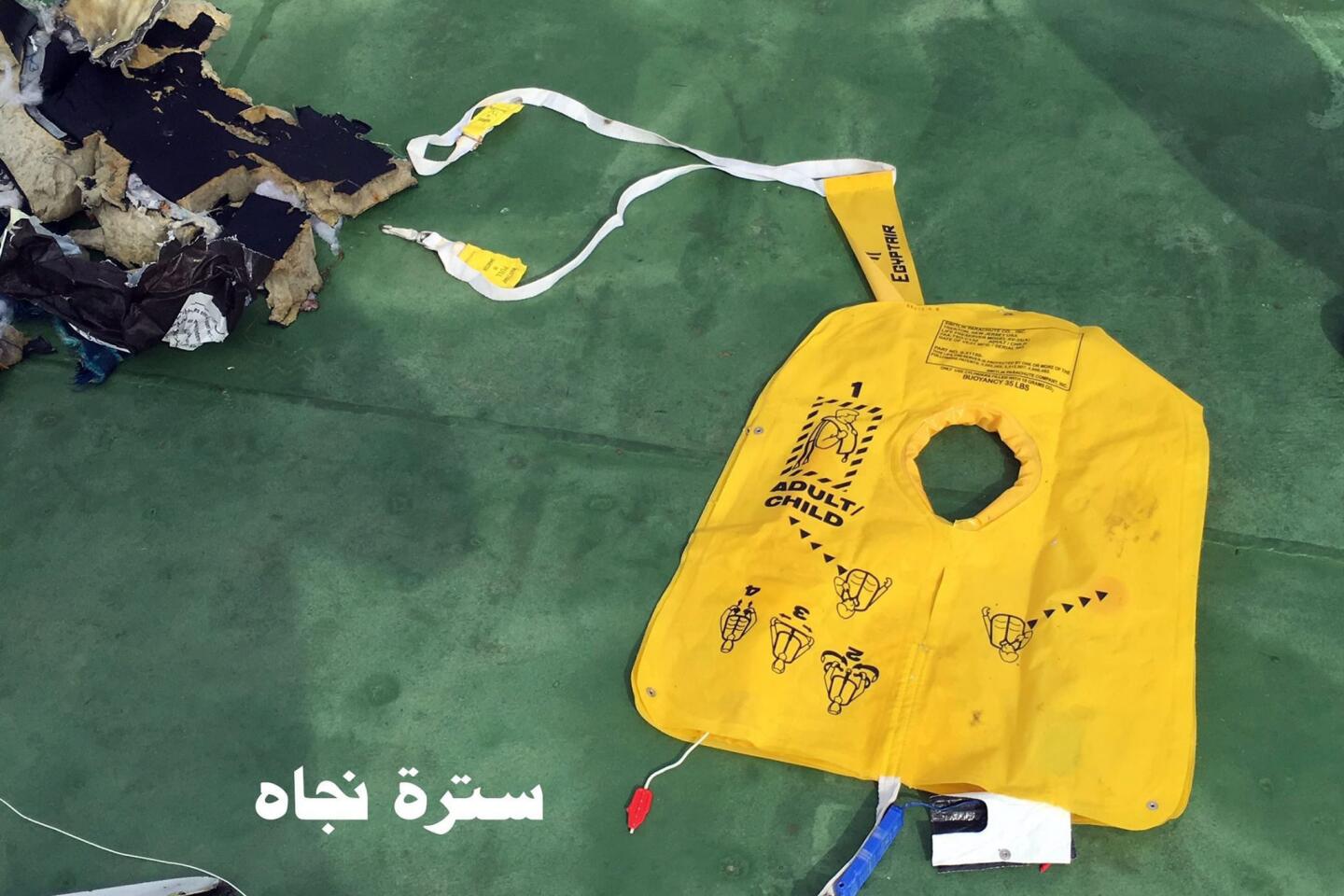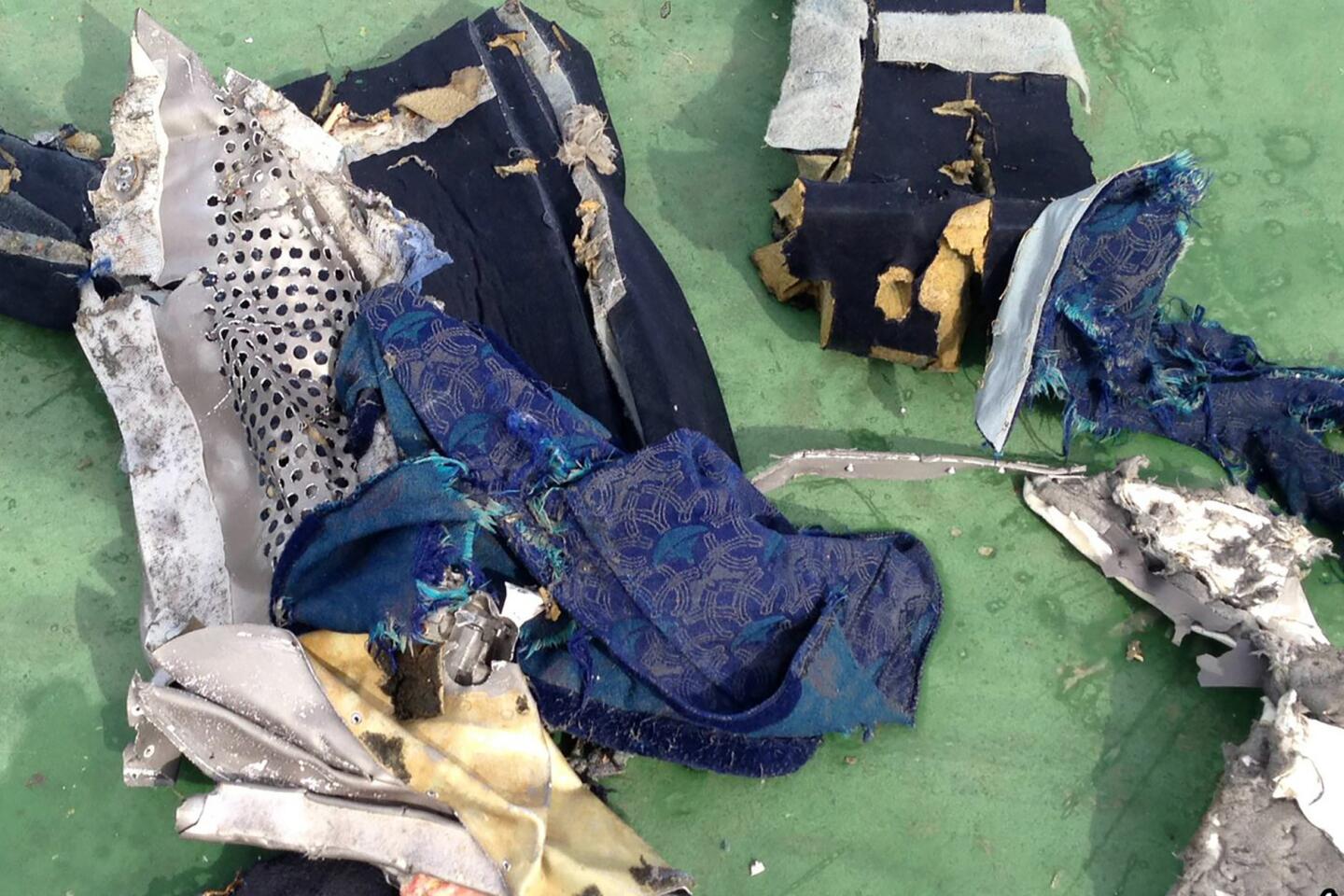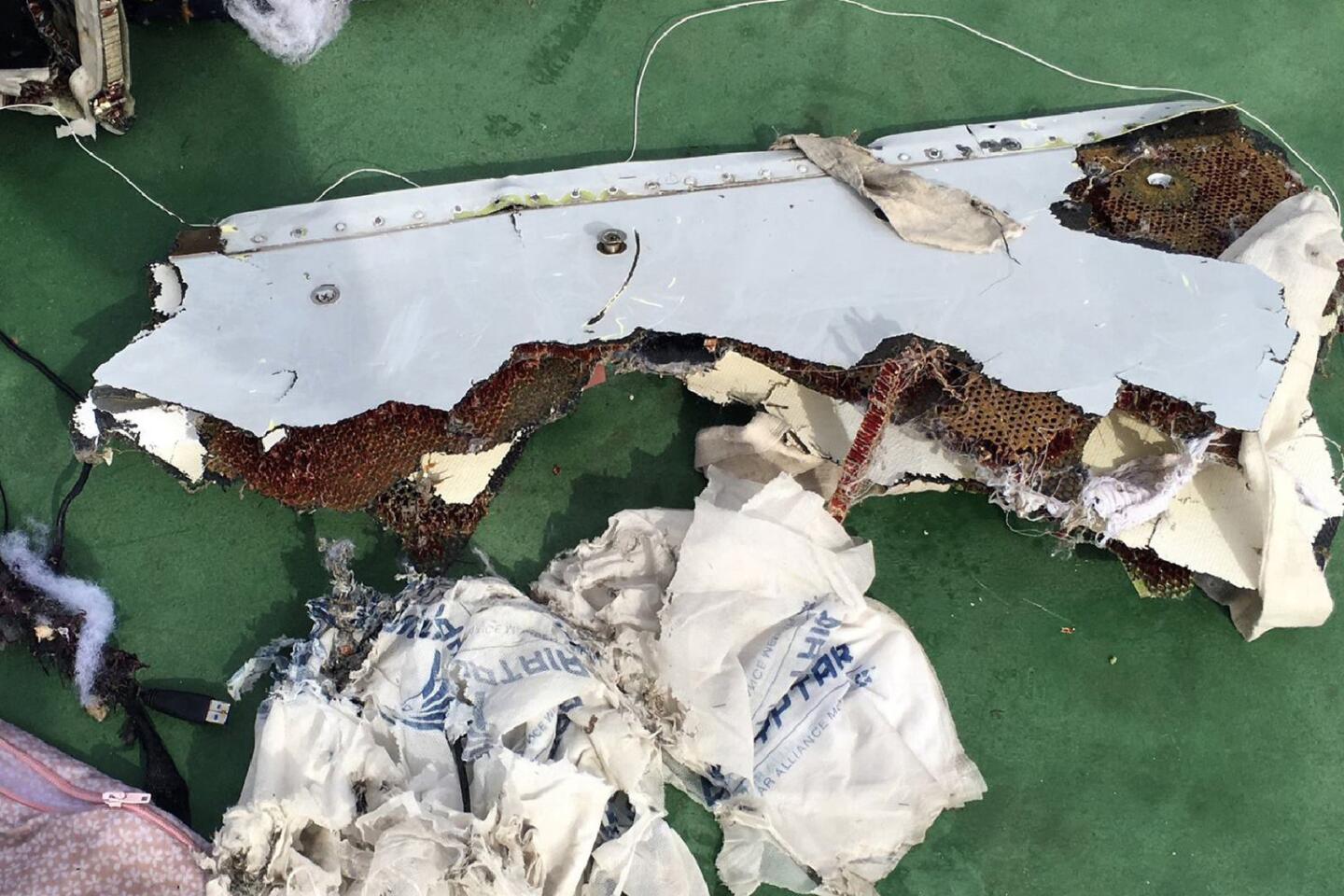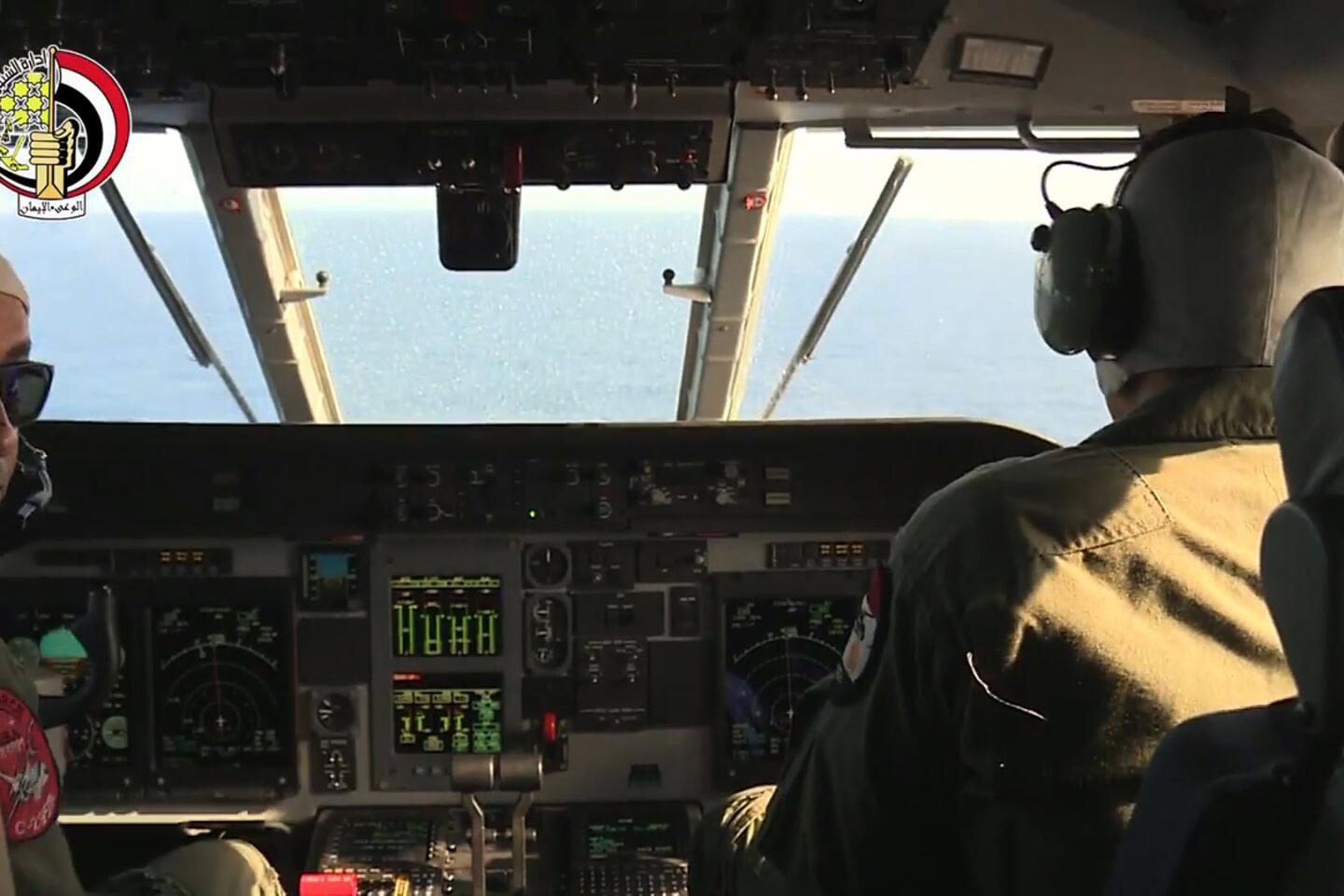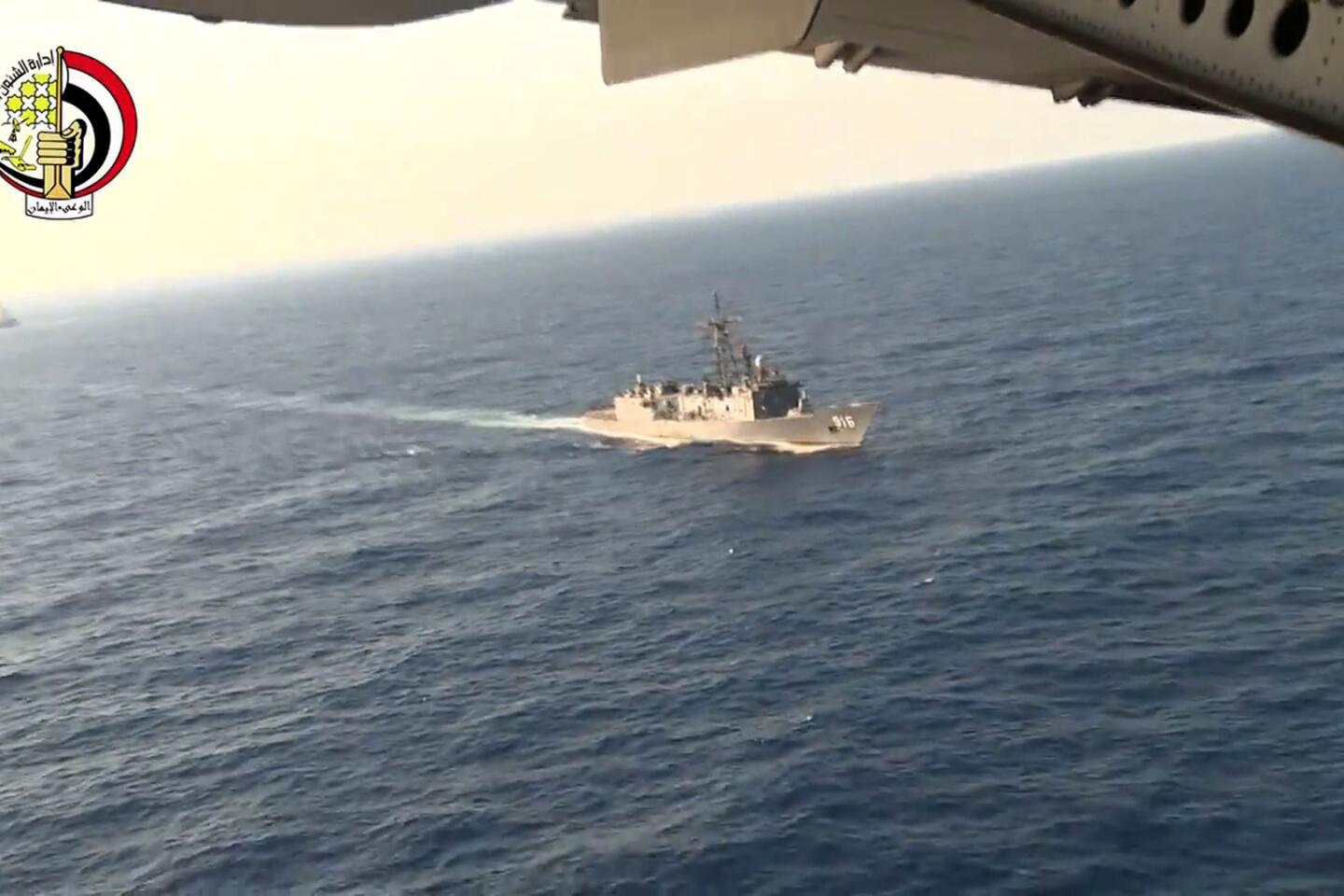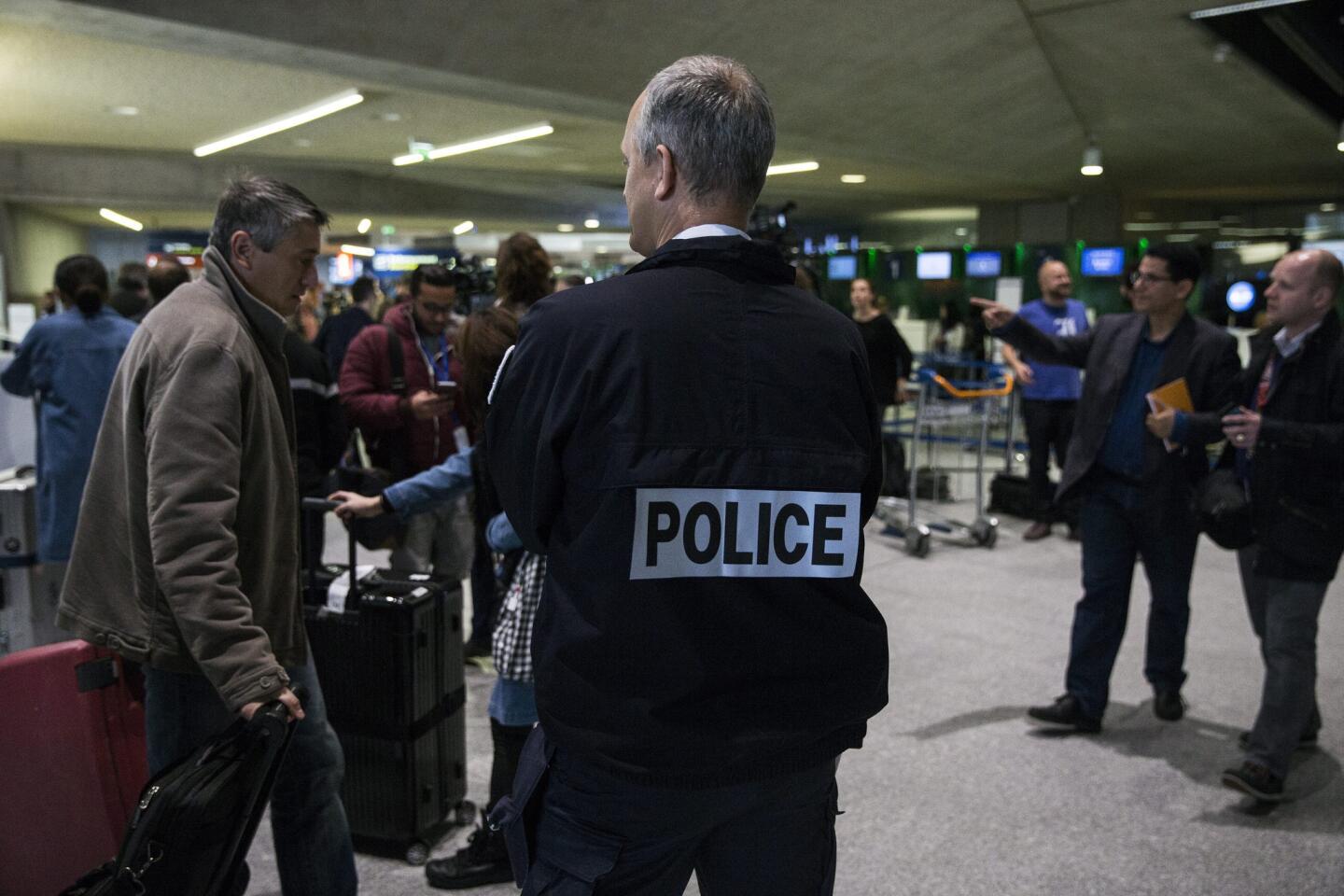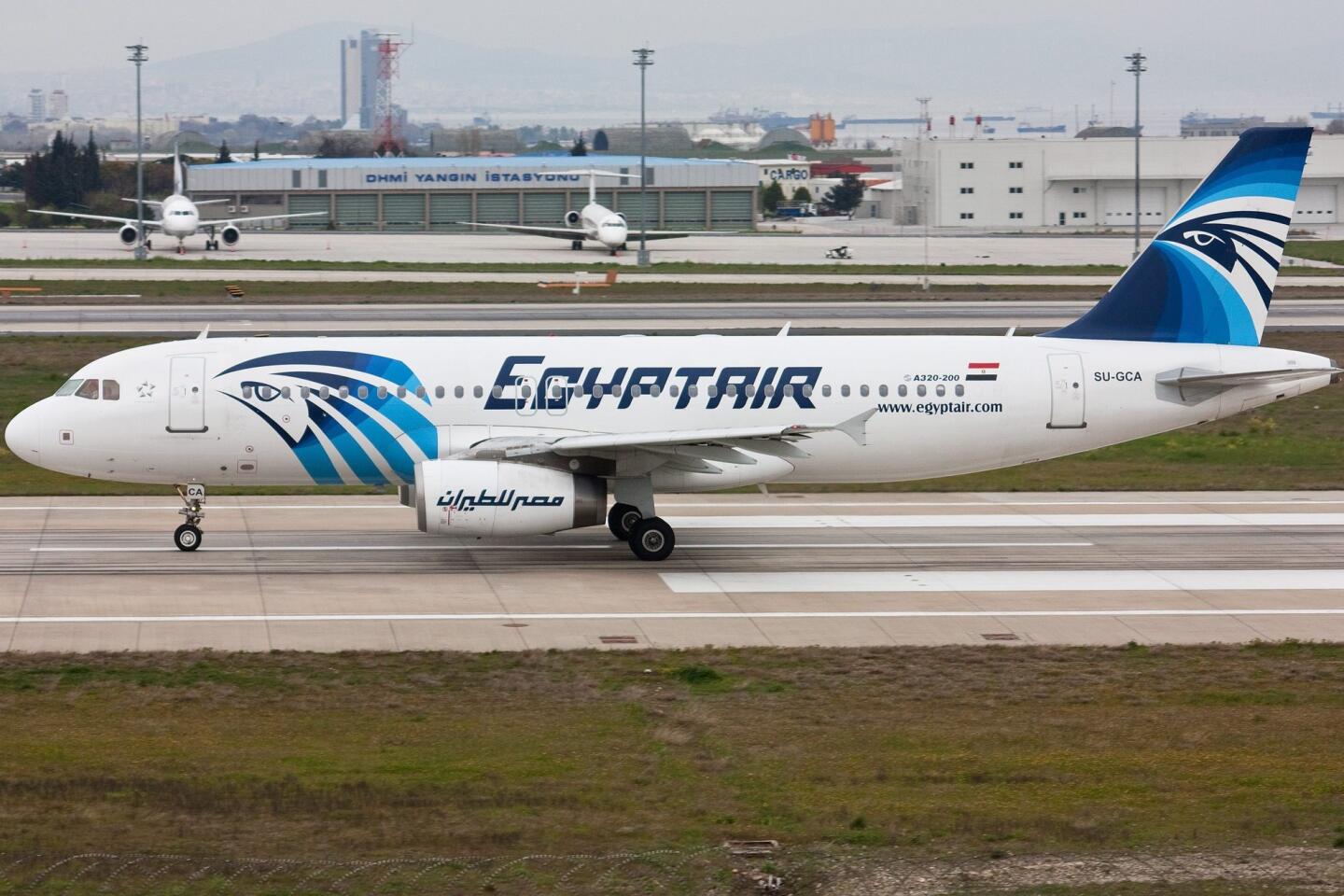Terrorists may have brought down EgyptAir flight, officials say

- Share via
Reporting from Cairo — Nearly four hours into a flight from Paris to Cairo, an Egyptian passenger plane with 66 people aboard abruptly swerved and plunged thousands of feet before vanishing from radar screens over the Mediterranean Sea, officials said.
The disappearance of EgyptAir Flight 804 was the third major air incident for the country in the past year. Investigators said it was too soon to rule out any possible causes for Thursday’s disaster, but suggested that terrorism was more likely than a technical failure.
The Airbus A320 left Paris’ Charles de Gaulle Airport for Cairo about 11:10 p.m. Wednesday carrying 56 passengers, seven crew members and three airline security personnel.
Greek air traffic controllers were the last to make contact with the plane, about 2:30 a.m., as it passed over the island of Kea, just south of the Greek mainland.
The pilot did not mention any problems, Kostas Litzerakis, the head of Greece’s civil aviation department, told reporters.
Shortly after entering Egyptian airspace, the plane made a 90-degree turn to the left, then a 360-degree circle to the right, dropping from 37,000 to 15,000 feet, Greek Defense Minister Panos Kammenos said at a news briefing in Athens. It disappeared from radar screens at about 10,000 feet, he said.
At 2:50 a.m., air traffic controllers confirmed they had lost contact with the plane, Egypt’s civil aviation minister, Sherif Fathi, said at a news conference in Cairo.
He cautioned that it was too soon to draw conclusions about what happened to the plane. But he acknowledged that the possibility of a terrorist attack was “higher than the possibility of having a technical failure.”
The calamity immediately brought to mind the disappearance of a Russian Airbus over the Sinai Peninsula in October, a crash that Moscow said was probably the result of a bomb.
A senior U.S. law enforcement official who was briefed on Thursday’s crash also said investigators were leaning toward a terrorist act but had not ruled out other scenarios.
Investigators were examining several possible reasons for the abrupt turns, but the theories all had holes that might not be filled until the wreckage and cockpit voice and flight data recorders are retrieved, according to the U.S. official, who was not authorized to comment publicly.
A bomb may have exploded aboard the aircraft, but an explosion at that altitude probably would have caused the plane to disintegrate, the official said. Radar data suggested the jetliner remained intact at least until it reached 10,000 feet.
A hijacker also could have tried to commandeer the aircraft, resulting in a struggle in the cockpit. But that situation probably would have generated a distress call.
It was also possible that a pilot might have intentionally crashed the plane. That’s what the U.S. National Transportation Safety Board concluded happened in 1999, when an EgyptAir flight from Los Angeles to Cairo crashed into the Atlantic Ocean about 60 miles south of Nantucket Island, Mass., killing all 217 people on board. Egyptian authorities blamed an unspecified mechanical failure.
A Greek Defense Ministry source said the government was investigating an account from a merchant ship captain of seeing a “flame in the sky” about 130 nautical miles south of the Greek island of Karpathos. However, U.S. reconnaissance satellites did not detect evidence of a large flash or explosion aboard the EgyptAir A320 jetliner, according to U.S. officials who spoke on condition of anonymity to discuss intelligence matters.
U.S. counter-terrorism officials were running the names on the flight manifest through terrorist watchlists to see whether any of the passengers or crew may have extremist ties, another U.S. official said, speaking on condition of anonymity in discussing the investigation.
President Obama’s top counter-terrorism advisor, Lisa Monaco, briefed him at the White House early Thursday.
In France, the suddenness of the aircraft’s disappearance also raised suspicions of foul play.
Jean-Paul Troadec, former head of the French air accident investigation bureau, told Europe 1 radio that it was unlikely to have been a mechanical failure.
“There’s a strong possibility of an explosion on board from a bomb or a suicide bomber,” he said.
“We could also consider a missile, which is what happened to the Malaysia Airlines aircraft in July 2014. If the crew didn’t send an alert signal, it’s because what happened was very sudden.”
“A problem with an engine or a technical fault would not produce an immediate accident,” he added. “In this case, the crew did not react, which makes us think of an explosion.”
French Foreign Minister Jean-Marc Ayrault was more guarded in his assessment. After visiting passengers’ families at a crisis center near Charles de Gaulle Airport, Ayrault called for solidarity and compassion for the “anguished families” and said speculation and theorizing should stop.
“We have to remain extremely careful before commenting or expressing theories about what happened,” he said.
Jean Serrat, a former French commercial pilot, told France’s BFMTV there were only three realistic hypotheses: The aircraft was hit by a missile, there was a “major technical incident” that led to it exploding mid-flight, or something exploded inside.
“One thing is certain, it happened suddenly. There was no message, no signal.... The pilots had no time to say anything, it happened so quickly.”
French President Francois Hollande called an emergency meeting at the Elysee Palace and spoke by telephone with his Egyptian counterpart, Abdel Fattah Sisi. Afterward, his office said the two countries would cooperate to find out what had happened.
“No hypothesis should be ruled out,” Hollande told reporters at the Elysee Palace.
Both nations are in the crosshairs of Islamist extremist groups.
Islamic State and Al Qaeda’s Yemen branch claimed responsibility for deadly attacks in the French capital last year, and the country remains on high security alert. On Thursday, the French Parliament voted to extend a state of urgency for two more months, which would cover the Tour de France bicycle race and the Euro 2016 soccer tournament.
Islamic State’s affiliate in the Sinai Peninsula is also involved in daily fighting against the Egyptian military there. The group said it brought down the Russian Airbus A321 operated by Metrojet that crashed in the Sinai in October, killing 224 people on board.
However, Israeli experts on the group say it is not known if it possesses the type of long-range weapon that could down a jet over the sea at night.
“As far as we know, they don’t have rockets that can reach the cruising altitude at which a plane flies,” said Aviv Oreg, a security consultant and former Israeli intelligence officer. “It was too high for their rockets.”
In March, an EgyptAir plane was hijacked and diverted to Cyprus. A man who admitted to the hijacking and is described by Cypriot authorities as “psychologically unstable” is in custody in that country.
Egyptian and Greek defense authorities mounted a search Thursday for the missing jetliner in the Mediterranean.
At Cairo International Airport, anguished relatives of the plane’s passengers and crew gathered at dawn hoping for news about their loved ones.
One woman emerged, sobbing, with her husband. She said that her son-in-law was one of the security personnel on the plane.
“We don’t know anything,” she said. “We don’t understand. We don’t know what happened to the plane.”
Fathi said officials were providing the families all the information available to them. “If someone wants to know now what happened to the plane, we can’t tell them, since we still do not know,” he said.
Of the 56 passengers, 30 were Egyptians, 15 were from France, two from Iraq and one each from Britain, Belgium, Saudi Arabia, Sudan, Chad, Portugal, Algeria, Kuwait and Canada. Two babies and a child were on the flight.
No Americans were listed on the passenger manifest. But U.S. officials were checking further to confirm that.
Adding to the families’ distress were a series of conflicting statements issued by Egyptian and Greek authorities during the course of the day.
EgyptAir initially said that the plane sent out a distress signal two hours after the last confirmed radar contact, but Fathi said that this was an error and that no emergency calls were made from the plane.
There were also reports that life vests and plastic debris had been found about 200 nautical miles southeast of the Greek island of Crete.
As night fell, EgyptAir issued a brief statement saying wreckage from the missing plane had been found near Karpathos. But Greek officials said the debris did not come from an aircraft, and EgyptAir’s vice chairman, Ahmed Adel, later retracted the statement.
The airline said the plane was on its fifth flight of the day, including stops in Tunisia and Eritrea earlier Wednesday. The captain had more than 6,000 flying hours, including 2,100 on the A320. The copilot had 2,766 flying hours.
EgyptAir said there was no freight, special cargo or dangerous goods on board.
Richard Aboulafia, vice president of analysis at the Teal Group, a Virginia-based aerospace research firm, said Airbus 320s are reliable aircraft and among the most common planes used in air travel. The plane went into service in 2003, which is not that old for a jet.
“That’s a sweet spot. It was nowhere near being toward the end of its life. It’s a classic young middle-aged aircraft,” Aboulafia said. “There’s absolutely no reason for it to do this unless there was an onboard struggle or an explosion.”
ALSO
World powers call for ‘air bridge’ to get humanitarian supplies into Syria
An ethnically charged dispute over electricity brings protesters into Kabul’s streets
A grandfather’s grief on the bloodiest day Baghdad has seen in months
Special correspondents Hassan and Willsher reported from Cairo and Paris, respectively, and Times staff writer Zavis from Los Angeles. Times staff writers Brian Bennett and W.J. Hennigan in Washington, Del Quentin Wilber in New York and Hailey Branson-Potts and Matt Pearce in Los Angeles contributed reporting, along with special correspondents Maria Petrakis in Athens, Christina Boyle in London and Joshua Mitnick in Tel Aviv.
UPDATES:
7:06 p.m.: Updated with three security officers among the 10 airline personnel on board.
6:18 p.m.: Updated with additional background and edited to tighten.
3:31 p.m.: Updated with analysis, details.
2:01 p.m.: Updated with EgyptAir’s vice president retracting statement that wreckage has been found.
1:28 p.m.: Updated with a senior Greek air safety official saying none of the debris found so far was from a plane.
11:25 a.m.: Updated with a report that debris likely belonging to the missing jetliner was found near Karpathos.
10:05 a.m.: Updated with authorities leaning toward a terrorist attack as an explanation for the cause of the disaster.
8:04 a.m.: Updated with information from the Greek Ministry of Defense.
7:15 a.m.: Updated with new information throughout from Egyptian authorities and reporting from the Cairo airport.
6:49 a.m.: Updated with new information about debris being discovered and a revised statement about a distress signal being sent out.
5:07 a.m.: Updated with comment from French President Francois Hollande.
4:10 a.m.: Updated with comment from an Israeli security consultant.
3:12 a.m.: Updated with comment from former pilot Jean Serrat.
2:02 a.m.: Updated with comment from former French air accident investigations chief Jean-Paul Troadec and an Airbus statement.
1:10 a.m.: Updated with new details throughout.
11:35 p.m.: Updated with officials saying the plane crashed.
10:56 p.m.: Updated with nationalities of the passengers.
10:20 p.m.: Updated with comments from Airbus and Greek officials.
9:39 p.m.: Updated with comments from the Egyptian civil aviation agency.
9:04 p.m.: This article was updated with information and background.
This article was originally published at 8:55 p.m. May 18.
Sign up for Essential California
The most important California stories and recommendations in your inbox every morning.
You may occasionally receive promotional content from the Los Angeles Times.
